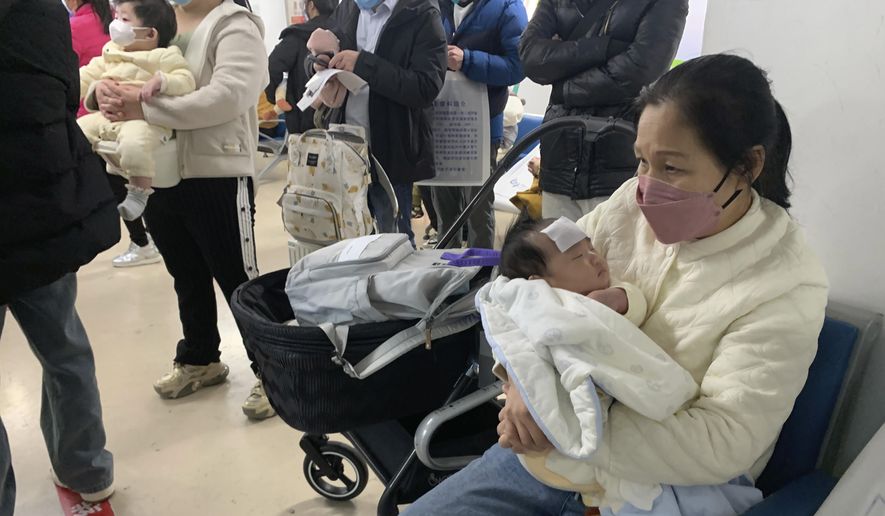China said Wednesday it would no longer track asymptomatic coronavirus cases as the Communist regime tries to navigate a sudden shift from its draconian zero-COVID policies and major cities report an uptick in infections.
The National Health Commission (NHC) said it would be impossible to get accurate statistics, given the lack of testing among those who aren’t feeling sick.
Officially, it reported 2,249 symptomatic COVID-19 cases nationally for the prior day. About 20% of them were in the capital, Beijing, which is experiencing an outbreak after the big shift in a virus policy that sparked economic hardship and rare public protests in multiple cities against the government.
Crowds have been reported around fever clinics in Beijing, where infections grew in number from 94 to more than 300 in recent days, according to the Associated Press. China’s population and health care system are struggling to adjust to a virus much of the rest of the world has learned to live with months ago.
Streets and popular sites have emptied because many people fear contracting the virus, as opposed to the result of another lockdown.
James M. Zimmerman, a Beijing-based lawyer and chairman of the American Chamber of Commerce in China, said the share of people in his office with COVID-19 grew from 50% to 90% in a matter of days.
“Some obviously miserable. Many nursing kids/parents at home,” he tweeted after a virtual call with co-workers. “Our ‘work at home’ policy is now ‘work at home if you’re well enough.’ This thing came on like a runaway freight train.”
Multiple outlets reported a run on pharmacies in Beijing and other places, as people try to stock up on cold and flu medicines in anticipation of virus symptoms. Some stores are imposing quotas on how much people can buy.
At least seven schools in Shanghai have reverted to remote schooling as the country adjusts to its new normal.
Also Wednesday, the health commission said it will roll out a second COVID-19 booster shot for at-risk persons and everyone over 60.
“For seniors unable or unwilling to take a shot from a syringe, inhalable COVID-19 vaccines are being rolled out in cities including Beijing and Shanghai, providing them a needle-free option to fend off the virus,” state media outlet Xinhua reported.
China is coping with the virus after the ruling Chinese Communist Party rolled back its longstanding zero-COVID policy last week following massive protests and the realization the policies might not be sustainable in the face of fast-moving spinoffs of the omicron variant.
The protests were sparked in part by a deadly fire in the western Xinjiang region. Some people believe COVID-19 restrictions made it difficult for people to escape or for first responders to reach the site.
The new guidelines would permit lockdowns only in “high-risk areas” and prohibit anyone from blocking fire escapes or apartment entrances.
Also, the guidelines let people quarantine at home instead of a special facility and move away from the QR codes that indicated a person’s health status and determined whether they could enter many places. Travelers within China won’t have to produce a negative test upon their arrival. Many people will travel to see family elsewhere in the country for the upcoming Lunar New Year.
The U-turn on the COVID-19 policy comes at a less-than-ideal time since infections are rising. Other countries tended to ease off restrictions when infections were down or declining.
It’s also an awkward turnabout for a government that, for three years, told its citizens to fear the virus and said the West was foolish in its approach. State broadcasters even reportedly limited the number of close-up crowd shots of the World Cup in Qatar so viewers wouldn’t see maskless spectators filling the soccer stadiums.
State media outlets insist the landscape has changed and the nation can shift from a war on the virus to self-care.
“With the weakening pathogenicity of the omicron, increasing uptake of vaccination and growing disease response experiences, China’s COVID-19 prevention and control work is facing new situations and new tasks,” the People’s Daily, the official newspaper of the communist party, reported.
Scientists, however, say China could experience waves of diseases due to its population’s relative lack of immunity. It didn’t see waves of prior infection due to its tight control and its vaccines are believed to be weaker than the ones used in the West.
While the official death toll in China from COVID-19 is far below that of the U.S. and other large nations, the World Health Organization recently warned it will be difficult for Beijing to suddenly emerge from years of lockdowns.
“In many ways, the pandemic has only just begun in China. The country was nearly closed off from the outside world for two years,” said Craig Singleton, a senior fellow at the Foundation for Defense of Democracies, a nonpartisan think tank. “The population is not inoculated, nor have the people built up antibodies on account of strict zero-COVID protocols and lockdowns. The country does not have a developed hospital system and Chinese authorities now acknowledge that the decision to scrap mandatory testing means that they lack fidelity about the true number of caseloads.”
Chinese President Xi Jinping, who was long personally invested in the zero-COVID approach, will hold high-level talks with members of the Politburo to chart a way forward for the country’s battered economy, Reuters reported. The Central Economic Work Conference will occur on Thursday and Friday.
Yet Mr. Xi has been absent from the airwaves in recent days and has let lower-level officials explain the sudden pivot in COVID-19 policies to the Chinese people, according to Mr. Singleton.
“If Xi’s message at the beginning of the pandemic was that the Chinese government knew best,” he said, “the new message for the Chinese people is that they are now on their own.”
For more information, visit The Washington Times COVID-19 resource page.
• Tom Howell Jr. can be reached at thowell@washingtontimes.com.




Please read our comment policy before commenting.